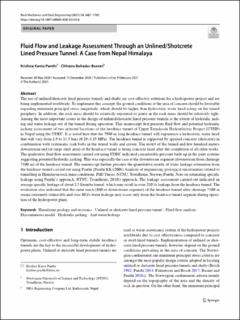| dc.contributor.author | Panthi, Krishna Kanta | |
| dc.contributor.author | Basnet, Chhatra Bahadur | |
| dc.date.accessioned | 2021-04-13T07:41:14Z | |
| dc.date.available | 2021-04-13T07:41:14Z | |
| dc.date.created | 2021-03-29T09:52:32Z | |
| dc.date.issued | 2021 | |
| dc.identifier.citation | Rock Mechanics and Rock Engineering. 2021, 54 1687-1705. | en_US |
| dc.identifier.issn | 0723-2632 | |
| dc.identifier.uri | https://hdl.handle.net/11250/2737426 | |
| dc.description.abstract | The use of unlined/shotcrete lined pressure tunnels and shafts are cost-efective solutions for a hydropower project and are being implemented worldwide. To implement this concept, the ground conditions at the area of concern should be favorable regarding minimum principal stress magnitude, which should be higher than hydrostatic water head acting on the tunnel periphery. In addition, the rock mass should be relatively unjointed or joints in the rock mass should be relatively tight. Among the most important issues in the design of unlined/shotcrete lined pressure tunnels is the extent of hydraulic jacking and water leakage out of the tunnel during operation. This manuscript first presents fluid flow and potential hydraulic jacking assessment of two selected locations of the headrace tunnel of Upper Tamakoshi Hydroelectric Project (UTHP) in Nepal using the UDEC. It is noted here that the 7960 m long headrace tunnel will experience a hydrostatic water head that will vary from 2.9 to 11.5 bars (0.29–1.15 MPa). The headrace tunnel is supported by sprayed concrete (shotcrete) in combination with systematic rock bolts in the tunnel walls and crown. The invert of the tunnel and few hundred meters downstream end (at surge shaft area) of the headrace tunnel is being concrete lined after the completion of all other works. The qualitative fluid flow assessment carried out using UDEC indicated considerable pressure built-up in the joint systems suggesting potential hydraulic jacking. This was especially the case at the downstream segment (downstream from chainage 7100 m) of the headrace tunnel. The manuscript further presents the quantitative results of water leakage estimation from the headrace tunnel carried out using Panthi (Panthi KK (2006) Analysis of engineering geological uncertainties related to tunneling in Himalayan rock mass conditions. PhD Thesis, NTNU, Trondheim, Norway;Panthi, Note on estimating specific leakage using Panthi’s approach, NTNU, Trondheim, 2010;) approach. The leakage assessment carried out indicated an average specific leakage of about 2.5 l/min/m tunnel, which may result in over 210 l/s leakage from the headrace tunnel. The evaluation also indicated that the outer reach (860 m downstream segment) of the headrace tunnel after chainage 7100 m seems extremely vulnerable and over 80 l/s water leakage may occur only from this headrace tunnel segment during operation of the hydropower plant. | en_US |
| dc.language.iso | eng | en_US |
| dc.publisher | Springer | en_US |
| dc.rights | Navngivelse 4.0 Internasjonal | * |
| dc.rights.uri | http://creativecommons.org/licenses/by/4.0/deed.no | * |
| dc.title | Fluid Flow and Leakage Assessment Through an Unlined/Shotcrete Lined Pressure Tunnel: A Case from Nepal Himalaya | en_US |
| dc.type | Peer reviewed | en_US |
| dc.type | Journal article | en_US |
| dc.description.version | publishedVersion | en_US |
| dc.source.pagenumber | 1687-1705 | en_US |
| dc.source.volume | 54 | en_US |
| dc.source.journal | Rock Mechanics and Rock Engineering | en_US |
| dc.identifier.doi | https://doi.org/10.1007/s00603-020-02350-6 | |
| dc.identifier.cristin | 1901555 | |
| dc.relation.project | Norges forskningsråd: 257588 | en_US |
| dc.description.localcode | This article is licensed under a Creative Commons Attribution 4.0 International License, which permits use, sharing, adaptation, distribution and reproduction in any medium or format, as long as you give appropriate credit to the original author(s) and the source, provide a link to the Creative Commons licence, and indicate if changes were made. The images or other third party material in this article are included in the article’s Creative Commons licence, unless indicated otherwise in a credit line to the material. If material is not included in the article’s Creative Commons licence and your intended use is not permitted by statutory regulation or exceeds the permitted use, you will need to obtain permission directly from the copyright holder. To view a copy of this licence, visit http://creativecommons.org/licenses/by/4.0 | en_US |
| cristin.ispublished | true | |
| cristin.fulltext | original | |
| cristin.qualitycode | 2 | |

